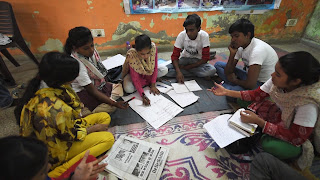Introduction
Have you heard of a newspaper for the street children? It is very much in existence in North India where the child labor and exploitation are at the maximum levels. The name of the newspaper is Balaknama. This newspaper is run by a group of street children who gather, compile and edit the news gathered from other street children. Currently, this newspaper is prevalent in the states of Delhi, Uttar Pradesh, and Haryana. In this blog post, we will see how this noble concept came into being, and how it changed the way people looked at the child labor after its emergence.
Newspaper for Street Children
Everyone knows that the street children are put to a lot of hardships by authorities, owners of shops where they are employed and other people in the society. These hapless children have been enduring this for a long period of time. Some of them wanted to respond in kind, resulting in the emergence of this unique concept that could one day mitigate their sufferings. They could have gone to the reputed newspapers or online magazines. They did not do that. Instead, they volunteered to become the reporters, writers, compilers and editors. They chose to call the new newspaper they came out with as Balaknama. The newspaper started reaching readers, primarily the street children for whom it is free. After distributing the newspaper copies to the children, the remaining ones are sold to the public at a nominal cost of Rs. 5.00. The newspaper has been in circulation for past 14 years. The number of copies has risen to 8000 this year. Initially, the cost of publication was borne by the children themselves through their little contributions. From the second year onwards, the cost has been borne by a Delhi-based Non-governmental Organization (NGO). In the formative years, the newspaper used to hit the shelves once in three months. Later, it became bimonthly (once in every two months). Bolstered by the response from the public, the newspaper has become a monthly feature in New Delhi, Uttar Pradesh, and Haryana.
Equipping Children
The NGO Chetana working for the street children’s cause decided to give them a lease of life. Chetana went all the way out to select 35 children by organizing camps for them at various places. These children were brought under a new organization by the name “Badte Kadam”. They were introduced to the world of letters and given the formal education. After equipping them with words, they were given training in journalism so that they can independently make and edit news from the events happening around them. The news is brought by the children to the one-room office of Balaknama in south Delhi. The editorial team is drawn from these children. The board under the senior editor then makes the assessment of the news items presented and picks the best ones for publishing. The child editor presides over a meeting of the reporters who bring the news from their localities. After making the suitable alterations, the news pieces are sent for publishing in the newspaper.
What Effects Did this Newspaper Bring in these Children’s lives?
NGO working with the street children is still conducting camps for the children to identify the latent talents that thrive on the roads and by-lanes of the capital city of the country. After undergoing the training, the children have become more self-reliant and expressive about their daily ordeals at the workplace. Unlike the modern-day newspapers, Balaknama minces no words and hit hard at the aberrations present in the life, especially those involving street children. For instance, the newspaper carried the narration of children who were forced to pick up dead body parts from the railway lines. This news piece created a lot of hue and cry in the public domain, forcing the National Child Rights Commission to take Suo Motto case against cops who forced the children to do this. In another case, the newspaper reported the story of another child who was forced to load and unload the garbage from the truck. This 8-year-old girl used to manually load the foul smelling garbage into the truck and unload the same from the truck at the destination. Apart from these, the child was asked to clean the whole truck after unloading the garbage. This has also shaken the national conscience, forcing the authorities to take some corrective steps.










0 Post a Comment:
Post a Comment